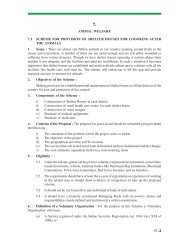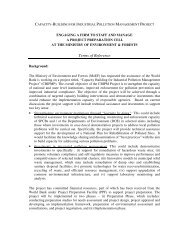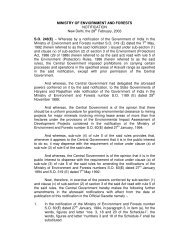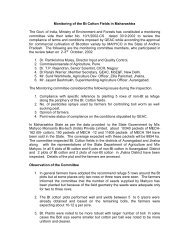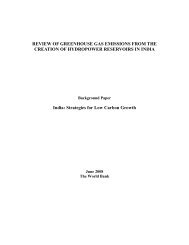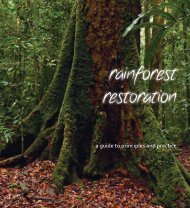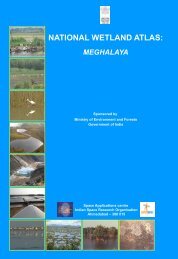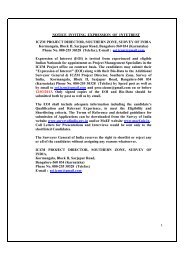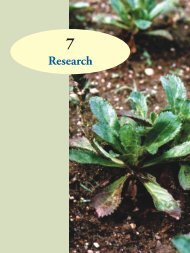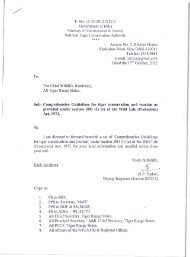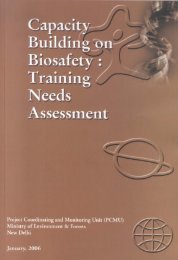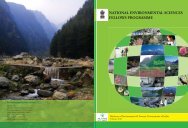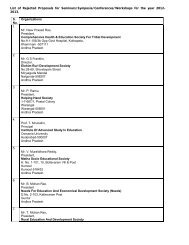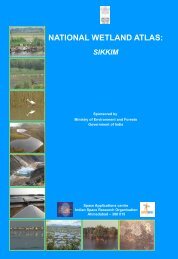Wetlands Atlas - Ministry of Environment and Forests
Wetlands Atlas - Ministry of Environment and Forests
Wetlands Atlas - Ministry of Environment and Forests
Create successful ePaper yourself
Turn your PDF publications into a flip-book with our unique Google optimized e-Paper software.
technique. Remote sensing is now recognised as an essential tool for viewing, analyzing, characterizing, <strong>and</strong><br />
making decisions about l<strong>and</strong>, water <strong>and</strong> atmospheric components.<br />
From a general perspective, remote sensing is the science <strong>of</strong> acquiring <strong>and</strong> analyzing information about<br />
objects or phenomena from a distance (Jensen, 1986; Lilles<strong>and</strong> <strong>and</strong> Keifer, 1987). Today, satellite remote<br />
sensing can be defined as the use <strong>of</strong> satellite borne sensors to observe, measure, <strong>and</strong> record the<br />
electromagnetic radiation (EMR) reflected or emitted by the earth <strong>and</strong> its environment for subsequent analysis<br />
<strong>and</strong> extraction <strong>of</strong> information. EMR sensors includes visible light, near-, mid- <strong>and</strong> far-infrared (thermal),<br />
microwave, <strong>and</strong> long-wave radio energy. The capability <strong>of</strong> multiple sources <strong>of</strong> information is unique to<br />
remote sensing. Of specific advantage is the spectral, temporal, <strong>and</strong> spatial resolution. Spectral resolution<br />
refers to the width or range <strong>of</strong> each spectral b<strong>and</strong> being recorded. Since each target affects different<br />
wavelengths <strong>of</strong> incident energy differently, they are absorbed, reflected or transmitted in different proportions.<br />
Currently, there are many l<strong>and</strong> resource remote sensing satellites that have sensors operating in the green,<br />
red, near infrared <strong>and</strong> short wave Infra red regions <strong>of</strong> the electromagnetic spectrum giving a definite spectral<br />
signature <strong>of</strong> various targets due to difference in radiation absorption <strong>and</strong> reflectance <strong>of</strong> targets. These<br />
sensors are <strong>of</strong> common use for l<strong>and</strong> cover studies, including wetl<strong>and</strong>s. Figure 1 shows typical spectral<br />
signature <strong>of</strong> few targets from green to SWIR region. Converted to image, in a typical false colour composite<br />
(FCC) created using NIR, red <strong>and</strong> green b<strong>and</strong>s assigned as red, green <strong>and</strong> blue colour, the features become<br />
very distinct as shown in Figure 2. In FCC, the vegetation thus appears invariably red (due to high reflection<br />
in NIR from green leaves).<br />
Since the early 1960s, several satellites with suitable sensors have been launched into orbit to observe <strong>and</strong><br />
monitor the earth <strong>and</strong> its environment. Most early satellite sensors acquired data for meteorological purposes.<br />
The advent <strong>of</strong> earth resources satellite sensors (those with a primary objective <strong>of</strong> mapping <strong>and</strong> monitoring<br />
l<strong>and</strong> cover) occurred, when the first L<strong>and</strong>sat satellite was launched in July 1972. Currently, more than a<br />
dozen orbiting satellites <strong>of</strong> various types provide data crucial to improving our knowledge <strong>of</strong> the earth’s<br />
atmosphere, oceans, ice <strong>and</strong> snow, <strong>and</strong> l<strong>and</strong>. Of particular interest to India is the indigenous series <strong>of</strong><br />
satellites called Indian Remote Sensing satellites (IRS-Series). Since the launch <strong>of</strong> the first satellite IRS 1A in<br />
1987, India has now a number <strong>of</strong> satellites providing data in multi-spectral b<strong>and</strong>s with different spatial<br />
resolution. IRS P6/RESOURCESAT 1 is the current generation satellite that provides multi-spectral images in<br />
spatial resolution <strong>of</strong> 5.8 m (LISS IV), 23.5 m (LISS III) <strong>and</strong> 56m (AWiFS). Over the past few decades, Indian<br />
remote sensing data has been successfully used in various fields <strong>of</strong> natural resources (Navalgund et al,<br />
2002).<br />
Development <strong>of</strong> technologies like Geographic Information System (GIS) has enhanced the use <strong>of</strong> RS data to<br />
obtain accurate geospatial database. GIS specialises in h<strong>and</strong>ling related, spatially referenced data, combining<br />
mapped information with other data <strong>and</strong> acts as analytical tool for research <strong>and</strong> decision making. During the<br />
past few decades, technological advances in the field <strong>of</strong> satellite remote sensing (RS) sensors, computerized<br />
mapping techniques, global positioning system (GPS) <strong>and</strong> geographic information system (GIS) has<br />
enhanced the ability to capture more detailed <strong>and</strong> timely information about the natural resources at various<br />
scales catering to local, regional, national <strong>and</strong> global level study.<br />
Figure 1: Spectral Signature <strong>of</strong> various targets<br />
2



